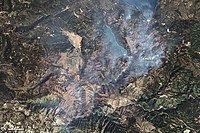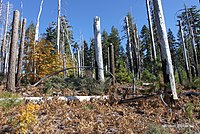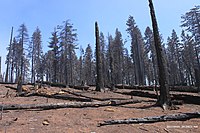
Butte County is a county located in the northern central part of the U.S. state of California. In the 2020 census, its population was 211,632. The county seat is Oroville.

Plumas County is a county located in the Sierra Nevada of the U.S. state of California. As of the 2020 census, the population was 19,790. The county seat is Quincy, and the only incorporated city is Portola. The largest community in the county is East Quincy. The county was named for the Spanish Río de las Plumas, which flows through it. The county itself is also the namesake of a native moth species, Hadena plumasata.

The Feather River is the principal tributary of the Sacramento River, in the Sacramento Valley of Northern California. The river's main stem is about 73 miles (117 km) long. Its length to its most distant headwater tributary is just over 210 miles (340 km). The main stem Feather River begins in Lake Oroville, where its four long tributary forks join—the South Fork, Middle Fork, North Fork, and West Branch Feather Rivers. These and other tributaries drain part of the northern Sierra Nevada, and the extreme southern Cascades, as well as a small portion of the Sacramento Valley. The total drainage basin is about 6,200 square miles (16,000 km2), with approximately 3,604 square miles (9,330 km2) above Lake Oroville.

Lake Almanor is a large reservoir in northwestern Plumas County, northeastern California, United States. The reservoir has a capacity of 1,308,000 acre-feet (1.613×109 m3) and a maximum depth of about 90 feet (27 meters). The surface area is 43.75 square miles (11,331.2 hectares). It is formed by Canyon Dam on the North Fork of the Feather River, as well as Benner and Last Chance Creeks, Hamilton Branch, and various natural springs.
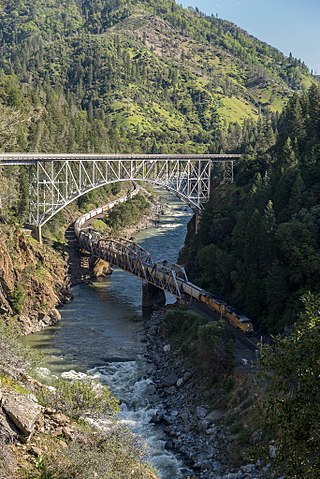
The North Fork Feather River is a watercourse of the northern Sierra Nevada and southern Cascades in the U.S. state of California. It flows generally southwards from its headwaters near Lassen Peak to Lake Oroville, a reservoir formed by Oroville Dam in the foothills of the Sierra, where it runs into the Feather River. The river drains about 2,100 square miles (5,400 km2) of the western slope of the Sierras. By discharge, it is the largest tributary of the Feather.
The Bucks Lake Wilderness is a 23,958-acre (97.0 km2) wilderness area located in the Plumas National Forest section of the Sierra Nevada, in northeastern California, United States.

In the summer of 2013, there were several major wildfires in Colorado in the United States. During June and July, record high temperatures and dry conditions fueled the fires all across the state. By July 24, 570 structures had been destroyed and 2 people died. Below is a list of the major fires of the year.

The Upper North Fork Feather River Project is a hydroelectric scheme in the Sierra Nevada of California, within Lassen and Plumas Counties. The project consists of three dams, five power plants, and multiple conduits and tunnels in the headwaters of the North Fork Feather River, a major tributary of the Feather—Sacramento River systems. The total installed capacity is 362.3 megawatts (MW), producing an annual average of 1,171.9 gigawatt hours (GWh). The project is also contracted for the delivery of irrigation water between March 31 and October 31 of each year. The project is owned and operated by Pacific Gas and Electric Company.

The 2018 Camp Fire in Northern California's Butte County was the deadliest and most destructive wildfire in California's history. The fire began on the morning of Thursday, November 8, 2018, when part of a poorly maintained Pacific Gas and Electric Company (PG&E) transmission line in the Feather River Canyon failed during strong katabatic winds. Those winds rapidly drove the Camp Fire through the communities of Concow, Magalia, Butte Creek Canyon, and Paradise, largely destroying them. The fire burned for another two weeks, and was contained on Sunday, November 25, after burning 153,336 acres (62,050 ha). The Camp Fire caused 85 fatalities, displaced more than 50,000 people, and destroyed more than 18,000 structures, causing an estimated $16.5 billion in damage. It was the most expensive natural disaster of 2018, and is a notable case of a utility-caused wildfire.
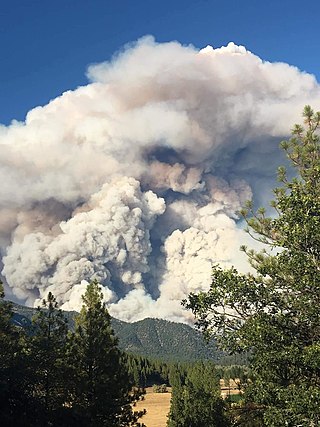
The Walker Fire was a wildfire that burned near Genesee Valley in the Plumas National Forest approximately 11 miles east of the community of Taylorsville in Plumas County, California. The blaze was reported on Wednesday, September 4, 2019 and immediately expanded in size over its several days of burning. The fire actively threatened homes from Genesee Valley to Antelope Road.

The 2020 Loyalton Fire was a large wildfire in Lassen, Plumas and Sierra counties in California and Washoe County in Nevada. After it was ignited by lightning on August 14, 2020, the fire burned 47,029 acres (19,032 ha) in the Tahoe National Forest and the Humboldt-Toiyabe National Forest before it was fully contained on August 26. The Loyalton Fire was notable for generating three fire tornadoes on August 15, necessitating first-of-their-kind warnings by the National Weather Service.

The North Complex Fire was a massive wildfire complex that burned in the Plumas National Forest in Northern California in the counties of Plumas and Butte. Twenty-one fires were started by lightning on August 17, 2020; by September 5, all the individual fires had been put out with the exception of the Claremont and Bear Fires, which merged on that date, and the Sheep Fire, which was then designated a separate incident. On September 8, strong winds caused the Bear/Claremont Fire to explode in size, rapidly spreading to the southwest. On September 8, 2020, the towns of Berry Creek and Feather Falls were immediately evacuated at 3:15 p.m. PDT with no prior warning. By September 9, 2020, the towns of Berry Creek and Feather Falls had been leveled, with few homes left standing. The fire threatened the city of Oroville, before its westward spread was stopped. The fire killed 16 people and injured more than 100. The complex burned an estimated 318,935 acres (129,068 ha), and was 100% contained on December 3. The fire was managed by the U.S. Forest Service in conjunction with Cal Fire, with the primary incident base in Quincy. The North Complex Fire is the eighth-largest in California's history, and was the deadliest fire in the 2020 California wildfire season.

The Cameron Peak fire was a wildfire that started near Chambers Lake, Colorado, 25 miles (40 km) east of Walden and 15 miles (24 km) southwest of Red Feather Lakes near Cameron Pass on August 13, 2020, and was declared 100% contained on December 2, 2020. The fire burnt 208,663 acres through the Arapaho and Roosevelt National Forests in Larimer and Jackson Counties and Rocky Mountain National Park. At its peak, the fire forced the evacuation of over 6,000 residents in Estes Park, Chambers Lake, Rustic, Glacier View Meadows, Red Feather Lakes, Masonville, Glen Haven, Spring Canyon, various small communities along Highway 14, Stove Prairie Landing Road, as well as the Colorado State University Mountain Campus and had over 1,000 personnel fighting the fire. 469 structures were destroyed by the fire, including 220 outbuildings and 42 primary residences. The fire became the largest wildfire in Colorado history, surpassing the Pine Gulch Fire, which had set the same mark just seven weeks prior.

The 2021 Dixie Fire was an enormous wildfire in Butte, Plumas, Lassen, Shasta, and Tehama counties in Northern California. Named after a nearby Dixie Road, the fire began in the Feather River Canyon near Cresta Dam in Butte County on July 13, 2021, and burned 963,309 acres (389,837 ha) before it was declared 100 percent contained on October 25, 2021. It was the largest single source wildfire in recorded California history, and the second-largest wildfire overall, The fire damaged or destroyed several communities, including Greenville on August 4, Canyondam on August 5, and Warner Valley on August 12.
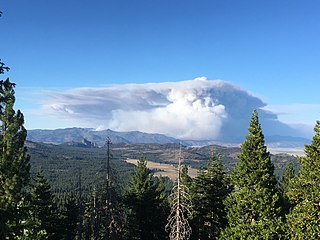
The Beckwourth Complex was a wildfire complex that burned in the Plumas National Forest in Plumas and Lassen counties. The two major fires of the complex, the Dotta Fire and the Sugar Fire, started on June 30 and July 2 northeast of Beckwourth, California. Started by lightning strikes, the two fires collectively burned 105,670 acres (42,763 ha). The complex resulted in the evacuation of numerous residential areas and the closure of portions of Plumas National Forest. In the community of Doyle, California, 33 homes were destroyed.

The Mosquito Fire was California's largest wildfire in 2022. The fire began on September 6, burned 76,788 acres in Placer and El Dorado counties in September and October, and was pronounced fully contained on October 22. It affected the Tahoe and Eldorado National Forests and destroyed 78 structures in the rural communities of Michigan Bluff, Foresthill, and Volcanoville. The fire suppression effort cost more than $180 million, and at its peak involved more than 3,700 firefighters. The precise cause of the fire is not known, but the possible role of Pacific Gas & Electric Company (PG&E) equipment is the subject of multiple civil lawsuits and a Forest Service investigation. The Mosquito Fire was one of 7,477 wildfires in California in 2022, which burned a combined 331,358 acres (134,096 ha).

The Storrie Fire was a sizeable wildfire in Northern California's Plumas County and the second-largest of California's 2000 wildfire season. The fire began on August 17, 2000, and was fully contained by September 9; it burned 55,261 acres in total and resulted in minimal property damage or casualties. The cost of containing the Storrie Fire amounted to $22 million.

The 2012 Reading Fire was a large wildfire in Lassen Volcanic National Park and the Lassen National Forest in Northern California. Ignited by a lightning strike on July 23, the fire was managed for ecological benefits by park officials until shifts in the weather caused the fire to jump its intended control lines. The Reading Fire ultimately burned 28,079 acres, partially outside the park, before it was fully contained on August 22, 2012. The fire destroyed no buildings and caused no fatalities or even serious injuries. The fire's unintended escape led members of the public and several California politicians to criticize park officials for allowing the fire to go unsuppressed after its discovery.

The Humboldt Wagon Road, or the Humboldt Road, was a freight wagon road in northern California. Constructed in the 1860s, it connected Chico, near the Sacramento River, with Susanville, near Honey Lake, east of the Sierra Nevada crest. From there, extensions continued to the Humboldt silver mines in Nevada and the Owyhee Mines near Silver City, Idaho. The road was surveyed and financed by prominent settler John Bidwell and carried passengers, mail, and freight between logging and ranching communities of northeastern California. It also contributed to the settlement of the region and the displacement of the native Maidu population. Portions of the Humboldt Road are now followed by California State Route 32 and California State Route 36.





